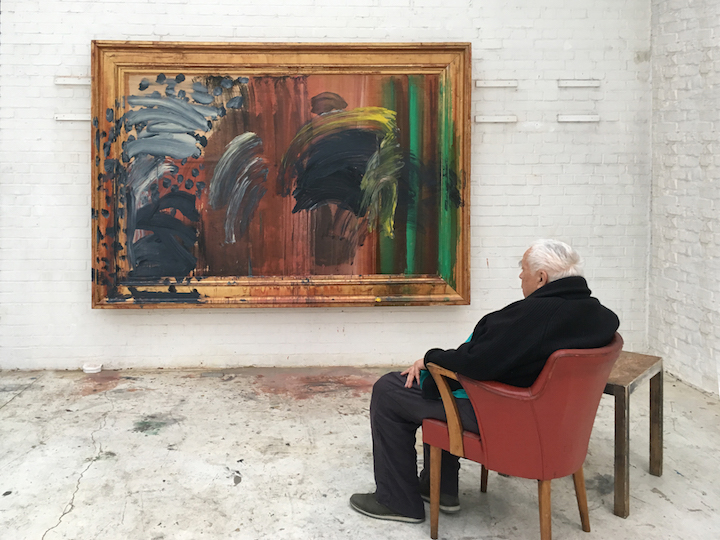The death of Howard Hodgkin (1932–2017) on 9 March brought to a close a long and distinguished artistic career. From his first painting, Memoirs (1949) – an extraordinarily precocious small gouache made at the age of 17 – Hodgkin ploughed an entirely distinctive furrow. From the outset, recollected memories were his central subject, and his paintings and prints are a unique and moving record of a highly personal endeavour to give pictorial substance to those nebulous experiences.
Memoirs (1949), Howard Hodgkin. © Howard Hodgkin
For more than 65 years, Hodgkin surveyed his past, and transmuted that autobiographical material – at first visual, but later increasingly compounded with emotion – into art. The nearest comparison is Marcel Proust, for whom the lure of involuntary memory became an irresistible source of literary inspiration. But Hodgkin never read the French novelist, nor was memory for him in any sense involuntary. By contrast, he went in search of his quarry, claiming that without a particular subject in mind he was unable to begin a picture. The absence of literal representation and, later, recognisable imagery clouded the way his work was viewed, however. It is a profound irony that despite the abiding presence of subject matter, throughout Hodgkin’s life and career the appellation ‘abstract painter’ obscured a proper appreciation of his achievement.
Nowhere was this more evident than in relation to Hodgkin’s portraits. Despite the international exposure that his work eventually received, and the conspicuous prominence that the evocation of a human presence assumed in his work, until recently it was still possible to hear the observation – even from the artist’s devotees – that ‘Hodgkin does not make portraits’. A wish to correct that misunderstanding formed the seed of the present survey of Hodgkin’s portraits – which I curated – at the National Portrait Gallery (until 18 June). Nor was I alone in that ambition. When I first put the idea for the show to Howard in 2014, his immediate response was ‘At last!’ He keenly wanted this important but frequently overlooked aspect of his art to be seen in the depth that it deserved. It was with a sense of relief, almost, that he committed to an exhibition that, sadly, he did not live to see.
Portrait of the Artist Listening to Music (2011–16), Howard Hodgkin. Courtesy Gagosian © Howard Hodgkin
I received the news of Howard’s death half an hour before hanging the first painting on day one of the installation. By some peculiar twist of fate, the work in question was Hodgkin’s last major painting, Portrait of the Artist Listening to Music (2011–16), which he had completed only three months earlier. Hodgkin spent the ensuing period in Mumbai, and went on to paint several wonderful smaller paintings during that final interlude. But the self-portrait was his last painting on a magisterial scale. Hodgkin worked on it with the exhibition in mind, and it forms an astonishing climax to a remarkable, sustained body of work.
As with so many of Hodgkin’s paintings, this large work was several years in formation. He had begun it five years previously and then put it aside. The reasons for that protracted gestation are not known, but perhaps the difficulty of bringing it to fruition was a factor. At various moments in his working life, Hodgkin would say, ‘I hate painting’, or ‘painting is agony’.
I often wondered about the nature of his suffering, which seemed so much at odds with the paintings themselves. These seemed suffused with joy, and filled with an evident sensuous pleasure in manipulating paint itself. But the challenge that Hodgkin set himself in the studio was formidable. Having begun always with a specific memory, the problem was how to evoke the original feeling he associated with an experience that now existed only in his own mind. As if chasing clouds, the supreme difficulty was that of giving physical substance to something formless, ever-changing and elusive. How can the past ever be captured and given shape, and an ineffable feeling be conveyed?
This was Hodgkin’s agony, and in the confinement of the studio he pursued his goal with a depth of commitment and a sureness of purpose that I regard as heroic. At some point, he returned to the painting that would prove to be his final portrait. No longer able to stand unassisted, while working on it he was held upright by his assistant Andy Barker. Throughout, he listened repeatedly to two pieces of music, both favourites from his youth. ‘The Last Time I Saw Paris’, composed by Jerome Kern and sung by Noel Coward, alternated with Anton Karas’s entrancing zither music from The Third Man. Carol Reed’s film was made in 1949, the same year that Hodgkin painted Memoirs, his first work.
Fragments from the soundtrack of Hodgkin’s own life, these musical compositions rekindled the past. Perhaps they also enabled him to confront the subject that underpins his work as a whole: the act of remembering, which he now evoked. The resulting image has a vital immediacy, Hodgkin’s finger movements clearly visible in passages of smeared paint. Preserving the artist’s presence, the painting is itself a memory – and a moving epitaph to the work of a great painter.
‘Howard Hodgkin: Absent Friends’ is at the National Portrait Gallery, London, until 18 June.
